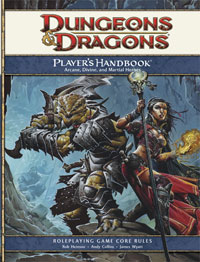Figuring Out the Players’ Thought Process
Our game group is back into a D&D campaign now (still 3rd edition D&D), and this past Thursday was our third game night in the first adventure. We’re running a “round robin” style game, with each Player taking a turn at DMing an adventure. Usually, when we play D&D, I’m the sole DM. I’m looking forward this new play style because it will let me play a character for a while. I think I really need to experience the Player side of the game more, especially with this group.
DMing for this group, there are many times I wonder over why they make certain decisions or choices, why they see certain things or fail to see certain things. When I ask the Players why, I often just don’t understand the answers. One of the Players has remarked many times “You just need better Players.” I don’t think these guys are bad Players, by any stretch of the imagination. They’re creative, intelligent, and generally observant (much more observant than I am most times). But sometimes they just don’t see things that for me is obvious (but as DM, I have all the answers literally written right in front of me), or they see things that I can’t figure out how they come up with. This is one reason I like playing a character in our games often: it lets me see the world from their perspective.
Let me give an example from this current adventure:
The party of adventurers are exploring a dungeon filled with a bunch of monsters. They come to one room where they encounter a big, bad demon monster. They engage it briefly (about 3 rounds of fighting), and find out that they can’t hurt it as they are currently prepared. So they pull back out of the room and regroup. Later, they reprepare their resources specifically to combat the demon. They charge back into the room and defeat the monster (7 rounds). This was all smart adventuring.
[As a side note: this 7-round battle took 40 minutes to play out with 6 characters, plus 2 animal companions and 1 summoned creature against the 1 demon and his 2 summoned creatures.]
In another encounter, the adventurers were trying to leave the dungeon and return to their home base. As they left the dungeon, a WHOLE BUNCH of low-level, low-intelligence monsters were between them and home.
The way I expected this mass combat to go was that the adventurers would see the enemies massing on them and so they would pull back to safety to regroup and come up with a plan for getting through them. (I can think of several ways this group of adventures could get through the mass of monsters.)
But what the adventurers did was to step just outside the dungeon exit and stay there, round after round after round. I explained that they could see more of these monsters coming from the surrounding area, and I directly mentioned that there were many, many more that they couldn’t see yet, but could hear in the distance. The adventurers stayed in their spots and pretty much slaughtered the weak enemies one after another (killing around 2-6 each round). But each round, more monsters arrived, and the adventurers weren’t really accomplishing anything against the swelling horde.
It wasn’t until the 8th round of the fight that one of the Players mentioned pulling back. By this time, there were so many dead monster bodies piled in places that virtual walls were forming from the corpses. On the 9th round, the adventurers starting pulling back into the dungeon, and on the 10th round they were fully disengaged (and the monsters didn’t follow them back inside). Only 1 adventurer and her animal companion had been seriously injured during the standing battle.
Afterwards, the Players didn’t seem too interested in the tactical challenge of getting through the horde. It seemed to be an annoyance to them. When I created the encounter, I had thought it would be a really cool challenge; something more than the cliched just hack the monster till it’s dead. I thought this scenario would be the type of battle talked about for a long time after — “Remember when we had to fight our way through that horde?”
[As a side note: this 10-round battle took 103 minutes to play out with 6 characters, plus 2 animal companions and 4 summoned creatures against never less than 40 monsters on the battlemap at any given time.]
Now, my question is this: How is it the Players realized they weren’t going to defeat the demon monster within a couple of rounds, but against the horde they just stayed there round after round after round . . .? I really want to see what these situations are like from the position of a Player in the game rather than just as the DM. I want to understand if things like this really aren’t obvious, or if the Players get into a mindset that they can’t awake from.
I’ve seen Players, before, get so fixated on things, especially in a battle, that they completely ignore things that to me, as DM, are obvious. I’ve also seen this happen with Players when I’m a Player beside them, but I can’t recall it happening to me, personally. (It may have and I just don’t remember it, though, or I didn’t realize I was doing it.)
Bullgrit
bullgrit@totalbullgrit.com






 Categories:
Categories: 


 I went by my local hobby/game store and bought the new Dungeons & Dragons Player’s Handbook. D&D 4th edition is out, now, and I’m interested to see what’s new and improved. So instead of writing a blog post right now, I’m gonna sit down and thumb through this book. Sadly though, I’m not real excited about it — I’m just very curious.
I went by my local hobby/game store and bought the new Dungeons & Dragons Player’s Handbook. D&D 4th edition is out, now, and I’m interested to see what’s new and improved. So instead of writing a blog post right now, I’m gonna sit down and thumb through this book. Sadly though, I’m not real excited about it — I’m just very curious.


